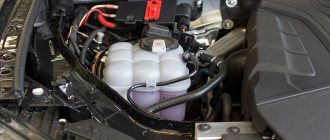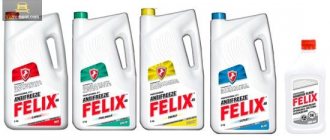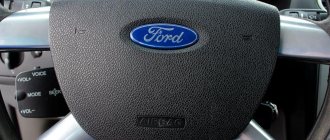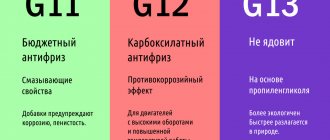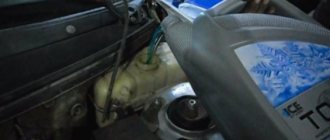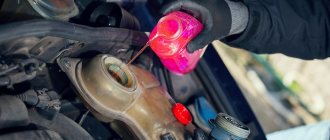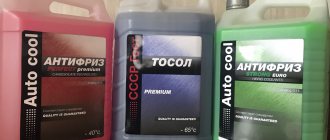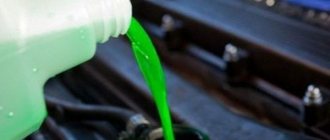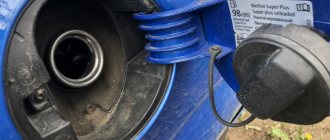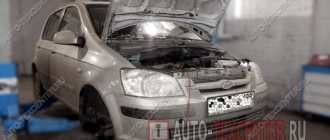High-quality antifreeze is the key to trouble-free operation of the engine cooling system. Many people believe that the requirements for antifreeze are small: as long as it does not freeze in winter and does not boil in summer. But in vain! In order to, as people say, “not catch a wedge” and not waste money on replacing a failed pump or a leaking radiator, you need to take the choice of antifreeze seriously.
From this article you will learn about what antifreeze is and why it is needed in a car. What types, classes and colors of automotive antifreeze are there? Which antifreeze is better: red, green or blue, and what is the difference between them?
For those readers who find it easier to perceive information by ear, we recommend watching the video at the very bottom of the page.
You can also find the following materials on our website:
- What is better - antifreeze or antifreeze, and is it possible to mix them?
- Flushing the cooling system before replacing antifreeze.
- Instructions for replacing antifreeze with your own hands.
In addition, we will provide many interesting facts about automotive coolants, their features and production technology.
Theoretical basis, or What is antifreeze
Antifreeze is the internationally accepted name for automotive coolant. Literally translated from English, the word Antifreeze means “non-freezing”. All types of antifreeze are produced on the basis of a glycol composition. Coolant concentrate contains:
- 90% of ethylene glycol is an oily substance that boils at 200 °C and freezes at -12 °C. Pure ethylene glycol is a strong poison and requires careful handling;
- 5–7% additives are components that improve the physical and performance qualities of the liquid;
- 3–5% - distilled water.
Classification of antifreeze by groups
Antifreezes are classified according to their chemical component, boiling point, freezing point, and their effect on parts and materials.
Antifreeze groups G11, G12 and G13
G11
Antifreeze G11 is a liquid containing ethylene glycol and distilled water, a proportion of inorganic additives and inhibitors that prevent the formation and spread of corrosion on metal and rubber elements of the cooling system. The presence of inorganic inhibitors affected the overall thermal conductivity performance. The fluid is only suitable for cars and units manufactured before 1996.
Main characteristics:
- Green sometimes blue.
- Density in the range of 1.065-1.085 g/cm3.
- Boiling point +108 degrees.
- Freezing at -45 and below.
- Service life - up to 2 years.
This type of coolant is similar to its Soviet counterpart under the Tosol brand.
G12, G12+ and G12++
Non-freezing types of coolant based on carboxylate additives and ethylene glycol. Contains no inorganic silicates. The main component of anti-corrosion protection is carboxylic acid. Compositions G12+, ++ differ from the original only in the amount of carboxylic acid, which contributes to the formation of a protective anti-corrosion film in places where rust forms.
Features of carboxylate antifreeze
Mechanical characteristics:
- Of red color.
- Density in the range of 1.065-1.085 g/cm3.
- Boiling point +118 degrees.
- Freezing: – 40.
- Service life - more than 5 years.
Grade 12 carboxylate antifreeze is suitable for modern high torque engines. The brand was stopped produced in 2005, replaced by more modern ones marked +.
G13
Lobrid coolant G13 is developed on the basis of propylene glycol. The component significantly reduced the toxic quality of the product. Anti-corrosion additives of the chemical component have not changed. They represent several varieties of silicate substances and carboxylic acids.
Features of silicate antifreeze
In terms of its properties and characteristics, G13 does not differ from 12 +++. The less toxic ethylene glycol was simply replaced to improve the environmental friendliness of the final product.
Kinds
Now, it should be noted that all brands of antifreeze contain similar concentrations of ethylene glycol and water. Consequently, liquids will differ in the composition of their additive composition. The difficulty of choosing lies in the fact that each country uses its own standards for classifying antifreeze. In our country, the properties of these products are regulated by GOST 28084-89. Different state standards do not interface with each other and are often outdated. It is this situation that creates confusion in the market. But a solution was unexpectedly found. The Volkswagen concern developed its own classification, which almost immediately began to be used by all coolant manufacturers. According to this division, automotive antifreezes are divided into the following types:
- G11;
- G12;
- G13.
Now you can understand the features and differences of the first two types.
Helpful information
Manufacturers of auto chemicals classify the entire former USSR as Europe, which is why we have a European antifreeze classification system. More precisely, not even European, but VAG. These are the same classes G11-G13 mentioned above.
Japanese antifreezes are also divided by color, but the color indicates the freezing point, not the composition or class. Red “Japanese” lasts up to -30 degrees, green - up to -25, yellow - up to -20.
In the USA there is no color policy. These are mainly red and green liquids containing nitrites. Nitrite antifreezes are prohibited for use in Europe. The closest substitutes for “Americans” are carboxylate antifreeze G12/13.
Russian “Tosol” comes in blue (operating temperature up to -40), green (under the G11 standard), red (operating temperature up to -50).
Is it possible to choose by color?
According to the accepted unofficial classification, it was planned to produce the following versions of coolants:
- G11 - inorganic origin, color blue or green.
- G12 - organic origin, red or pink color.
Most coolant manufacturers adhere to these standards. But we must remember that such standardization is unofficial. Therefore, you can sometimes find antifreeze painted in the brand’s corporate color or a liquid of any shade. Therefore, you cannot base your choice solely on the color of the composition; it is better to always pay attention to the labeling of the composition.
You might be interested in: What is the difference between antifreeze?
When to change antifreeze
Most often, the manufacturer himself indicates the service life of his technical fluids. You can view them on the Internet or on the antifreeze container itself. Typically, the coolant lifespan is two years. There are also so-called long-acting antifreezes that will last about four years.
However, it should be remembered that if the car has to drive in difficult conditions, for example, off-road or in frequent traffic jams, the load on the engine increases many times, so the technical fluid will have to be replaced earlier than specified. So it never hurts to look into the expansion tank and check the antifreeze. If the fluid level is below the minimum mark, it must be replaced. The same should be done if the antifreeze has changed its color or if corrosive deposits have become noticeable in it.
Features of the G12 brand
Coolants of this group are produced on a carboxylate basis. This formula has a fundamentally different principle for protecting power unit components. Modern engines have virtually no copper or brass components that could be destroyed by the glycol base. But steel and aluminum are actively used in the design of power units. These metals form a corrosive film even with slight contact with water. G12 antifreeze additives effectively prevent the formation of an oxide film on the surface of metal surfaces. Thus, the composition extends the engine life. Coolant in this category is often called Long Life, since its service life is significantly longer than that of G11.
What does G12 antifreeze consist of?
The G12 class antifreeze concentrate includes:
- dihydric alcohol ethylene glycol about 90% of the total volume, which is needed to prevent freezing;
- distilled water , about five percent;
- dye (color often identifies the class of coolant, but there may be exceptions);
- additive package of at least 5 percent, since ethylene glycol is aggressive towards non-ferrous metals, several types of phosphate or carboxylate additives based on organic acids are added to it, acting as an inhibitor to neutralize the negative impact. Antifreezes with different sets of additives perform their functions differently, and their main difference is in the methods of combating corrosion.
In addition to corrosion inhibitors, the set of additives in the G12 coolant includes additives with other necessary properties. For example, the coolant must have anti-foaming, lubricants and compounds that prevent the appearance of scale.
Is it possible to mix G11 and G12?
From the very beginning of the appearance of the “G” marking, many myths appeared regarding the compatibility and interchangeability of compositions. Some drivers believe that coolant can only be added if the color matches. Others are sure that only antifreezes from the same manufacturer can be mixed. It must be said right away that you cannot rely on color - this is a very informal characteristic. Only liquids of the same brand can be mixed. Ideally, use the original antifreeze recommended by the car manufacturer. It is strictly forbidden to mix compositions of different types. For example, if G12 is added to a system with exhausted G11, then copper and brass elements will lose protection and will be quickly destroyed by corrosion.
Which brand of antifreeze to choose
The most rational option for choosing a coolant for a car is the technical parameters of the car, taking into account the tolerance. Each brand of car has a specific approval specification. For example:
- For a BMW car, BMW specification No. 600. 69. 0.
- For Volkswagen, the VW TL approval is 774.
- For a Ford car there is a specification FORD SSM - 97B 9102 A.
Exact data can be found in the machine’s operating manual, or from official dealers on their website.
What to do if there is no choice?
Sometimes motorists are faced with a situation where there is simply no access to suitable coolant. Obviously, it is better to try to find a less than suitable alternative than to overheat the engine. Nothing critical will happen by adding a small amount of another type of liquid. But it is still better to remember the following recommendations:
- try to mix antifreezes with the same base (for example, you can add ethylene glycol to ethylene glycol);
- silicate-free coolant cannot be mixed with any other compounds;
- If the wrong antifreeze was used, it is better to flush the cooling system. For the procedure, you need to use special liquids, widely available in auto chemical stores.
What is the difference between antifreezes
Silicate-type antifreeze completely envelops the inner walls of the cooling system, protecting it from corrosion. Already existing pockets of corrosion are localized by carboxylate additives. The disadvantages of such antifreezes include reduced heat dissipation (due to the film that protects against corrosion) and a relatively short service life.
Carboxylate-type antifreezes do not form a protective film; they are adsorbed only in places where corrosion occurs, forming a protective layer no thicker than 0.1 microns, thereby providing excellent heat removal.
Unknown fluid in the cooling system
Sometimes motorists simply do not know what type of coolant is used in the car. Most often, this situation arises after purchasing a used car. In this matter, you cannot simply try to guess the preferences of the former owner. Experts recommend following the following scenarios.
- If you need to fill up to 200 ml. In this case, you can safely add distilled water to the cooling system. These actions will not lead to an incorrect change in the balance of the additive composition. Essentially, you will simply add water that has boiled away due to excess pressure. Adding distilled water can be called a restorative process.
- If you need to add more than 200 ml. This need usually arises when there are problems with the radiator or system lines. The ideal solution is a complete replacement of antifreeze. All other actions will force you to hope for luck.
Which coolant is best to use?
When choosing cooling compounds, you need to take into account the following nuances:
- Radiator material. For radiators made of brass and copper materials, G11 is more suitable. For aluminum, you can use G12+, ++, +++ and G13 fluids. 12 is not suitable for copper and brass materials.
- Ambient temperature. Modern liquids with a high boiling point are suitable for hot climates. A difference of 10-20 degrees can make a big difference. Antifreezes G11 and Tosol are more suitable for working in low temperature conditions.
- Cars differ in power, torque, and overall cooling system. Modern cars are not suitable for G11, 12, or “Antifreeze” fluids. New machine models have improved cooling systems with high pressure and high speeds.
Important! You need to fill in the fluid that is indicated in the technical documentation for the car.
You may also be interested
Antifreeze Sintec Lux OEM G12 red: description and properties
Carboxylate antifreezes are common on the market; among the company’s products, class twelfth antifreeze includes SINTEC LUX OEM G12/S12 antifreeze. This is a red liquid, which is packaged in 1 kg, 3 kg and 5 kg bottles, as well as in 10 liter and 20 liter canisters.
Antifreeze green or red: what is the difference, what is the difference and differences between coolants
Everyone knows that you need to buy only high-quality coolant - this is natural. Today, car dealerships offer a very large assortment of antifreeze. In this article we look at the differences between green and red antifreeze.
Antifreeze which company to choose
1. Tosol-Sintez is Russia’s largest manufacturer of motor oils and other auto chemicals. After the development of investments in the amount of 1 billion rubles in 2007, the product line expanded significantly: brake fluids and pads, glass washers and bulk mixtures, auto cosmetics and Felix antifreeze. High-quality goods are supplied to 15 neighboring countries.
2. Liqui Moly is a rapidly growing German company producing over 6 thousand products. Over more than half a century of development, it has earned credibility in the market of auto chemicals and motor oils - it is among the leaders in sales, selling products in 120 countries around the world. The manufacturer's antifreeze products are well-deservedly popular among motorists.
3. Motul is a famous French company founded in 1853 in New York. It produces lubricants for engines of industrial machines and vehicles, and works closely with automotive giants. Pays special attention to the environment - produces synthetic biodegradable products.
4. “Obninskorgsintez” is a young Russian company that produces auto lubricants, motor oils, and Sintec antifreezes. Sixteen years of hard work have yielded results - the manufacturer’s products are in demand not only in the Russian Federation, but also in the CIS countries.
Recommendations:
6 best brake fluids
7 best antifreezes
Legend
| Designations | Units | Names |
| ρ | g/cm3 | Density |
| pH | – | pH value |
| T s | ‒°C | Freezing point |
| T k | +°C | Boiling temperature |
| C | thousand ₽ | Price 1 kg (l) as of 01.2017 |
| Color | – | Color |
Let's sum it up
The engine is one of the most expensive components of a car, so its maintenance and functionality should be treated with the utmost responsibility. High-quality cooling of the power unit is the key to its long operational period, therefore experimenting with antifreeze is more than unreasonable. Fill the system only with refrigerants that, in terms of technical properties, absolutely comply with the requirements of the car manufacturer - this will help you avoid many problems with the performance of the vehicle and will significantly extend its service life.
Compatibility and color
The color of the liquid does not affect the properties and characteristics in any way. Manufacturers can paint their products in different colors, but there are certain standards. The most popular compositions are colored green, blue, red, pink, and orange. Some standards even regulate liquids of certain shades. But the color of the coolant is the very last criterion that must be taken into account.
Very often, green color indicates G11 antifreeze. Lukoil and other manufacturers produce just such products. It is believed that green is the lowest class G11 or silicate product.
Antifreeze G11. Characteristics
Antifreeze G11 belongs to hybrid coolants. Its base is ethylene glycol. This antifreeze contains organic inhibitors (carboxylate), inorganic (silicates), as well as phosphates and nitrites. The color of this coolant is usually blue or green.
Antifreezes of this type were used in older cars, up to about 1990-1995, that had large volumes of cooling systems. Such liquids create a protective film on the entire internal surface of the system. This is good in terms of protection against corrosion, but such a protective film slightly impairs thermal conductivity and, accordingly, engine cooling.
The boiling point of G11 antifreeze is 105 °C. Service life is about 2 years or approximately 50 thousand kilometers.
